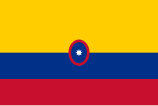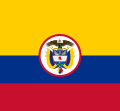Flag of Colombia
This article needs additional citations for verification. (May 2020) |
 | |
| El Tricolor Nacional ("The National Tricolor") | |
| Use | National flag and state ensign |
|---|---|
| Proportion | 2:3 |
| Adopted | 26 November 1861 |
| Design | A horizontal tricolour of yellow (double-width), blue and red. |
 | |
| Use | Civil ensign |
| Proportion | 2:3 |
| Design | The national flag defaced in the centre with a blue ellipse outlined in red and an eight-pointed white star. |
 | |
| Use | Naval ensign |
| Proportion | 2:3 |
| Design | The national flag defaced in the centre with a white circle outlined in red and the coat of arms of Colombia. |
The national flag of Colombia symbolises Colombian independence from Spain, gained on 20 July 1810.[1] It is a horizontal tricolor of yellow, blue and red. The yellow stripe takes up a half of the flag and the blue and red take up a quarter of the space each.
Symbolism and design


The horizontal stripes (from top to bottom) of yellow, blue and red tricolor have a ratio of 2:1:1. It—together with that of Ecuador, also derived from the flag of Gran Colombia—is different from most other tricolor flags, either vertical or horizontal, in having stripes which are not equal in size. (Venezuela, whose flag is also derived from the same source, opted for a more conventional tricolor with equal stripes).
The official colors have not yet been established by law. The Colombian Olympic Committee approved the following colors for the London 2012 Summer Olympics:[2]
Colours scheme |
Yellow | Blue | Red |
|---|---|---|---|
| Pantone | 116 | 287 | 186 |
| RGB (hex) | 252-209-22 (#FCD116) | 0-56-147 (#003893) | 206-17-38 (#CE1126) |
| CMYK | C0-M17.1-Y91.3-K0 | C100-M61.9-Y0-K42.4 | C0-M91.7-Y81.6-K19.2 |
According to the current interpretation, the colors signify:
- Yellow: Represents the riches of the country, the wealth of the Colombian soil, the gold, sovereignty, harmony, justice and agriculture, as well as the Sun, the source of light.
- Blue: Represents the sky above, the seas on Colombia's shores, and the rivers that run through.
- Red: Represents the blood spilled for Colombia's independence and also the effort of Colombian people, their determination and perseverance. It represents that although Colombia's people once struggled, they have since thrived.
The flag's colors have other representations, such as blue for loyalty and vigilance, red for the victory of battles for Colombian independence, and yellow for sovereignty and justice.
History
Francisco de Miranda originally created the common yellow, blue, and red flag of Gran Colombia that Colombia, Ecuador and Venezuela, with slight variations, share today. Miranda gave at least two sources of inspiration for his flag. In a letter written to Count Simon Romanovich Woronzoff and philosopher Johann Wolfgang von Goethe, Miranda described a late-night conversation he had had with Goethe at a party in Weimar during the winter of 1785. Fascinated by Miranda's account of his exploits in the United States Revolutionary War and his travels throughout the Americas and Europe, Goethe told him that, "Your destiny is to create in your land a place where primary colors are not distorted.” He proceeded to clarify what he meant:
First he explained to me the way the iris transforms light into the three primary colours […] then he proved to me why yellow is the most warm, noble and closest to [white] light; why blue is that mix of excitement and serenity, a distance that evokes shadows; and why red is the exaltation of yellow and blue, the synthesis, the vanishing of light into shadow.
It is not that the world is made of yellows, blues and reds; it is that in this manner, as if in an infinite combination of these three colours, we human beings see it. […] A country [Goethe concluded] starts out from a name and a flag, and it then becomes them, just as a man fulfils his destiny.
After Miranda designed his flag based on this conversation, he recalled seeing a fresco by Lazzaro Tavarone in the Palazzo Belimbau in Genoa that depicted Christopher Columbus unfurling a similar-colored flag in Veragua during his fourth voyage.[3][better source needed]
In his military diary, Miranda gave another possible source of inspiration: the yellow, blue and red standard of the Burger Guard (Bürgerwache) of Hamburg, which he also saw during his travels in Germany.[4][5]
In the 1801 plan for an army to liberate Spanish America, which he submitted unsuccessfully to the British cabinet, Miranda requested the materials for "ten flags, whose colors shall be red, yellow, and blue, in three zones."[6] However, the first flag was not raised until 12 March 1806, in Jacmel, Haiti, during his ill-fated expedition to Venezuela.
Gallery of flags
National flag
Historical flags
-
 Flag of United Provinces of New Granada (1811-1814), later adopted and used by Jean Lafitte from 1817 to 1821 at Galveston Island, Spanish Texas, New Spain
Flag of United Provinces of New Granada (1811-1814), later adopted and used by Jean Lafitte from 1817 to 1821 at Galveston Island, Spanish Texas, New Spain -
 Flag of Gran Colombia (1819)
Flag of Gran Colombia (1819) -
 Flag of United States of New Granada (1861)
Flag of United States of New Granada (1861)
Military and civil flags
-
Civil ensign of Colombia
-
Naval ensign of Colombia
-
Military flag of Colombia
-
Presidential flag of Colombia
Historical military and civil flags
-
 Civil ensign of Granadine Confederation (1858-1861)
Civil ensign of Granadine Confederation (1858-1861) -
 Military flag and naval ensign of Republic of New Granada (1834-1858)
Military flag and naval ensign of Republic of New Granada (1834-1858) -
 Civil ensign of United States of Colombia (1861-1886)
Civil ensign of United States of Colombia (1861-1886)
Construction sheets
-
Construction sheet of the national flag
-
Construction sheet of the civil ensign
-
Construction sheet of the naval ensign
-
Construction sheet of the military flag
-
Construction sheet of the presidential flag
Gallery of images
-
Colombian tricolor waving in Bogotá.
-
Colombian flag hoisted on the ARC Gloria barque, the official flagship of the Colombian Navy.
-
Colombian tricolor in a colonial building corridor in Cartagena de Indias.
-
Colombian roller skater celebrating her victory at the youth Olympics with a Colombian flag.
-
Olympic Champion Caterine Ibargüen celebrating her first world title at the 2013 World Championships in Athletics in Moscow.
See also
References
- ^ "Flag and Arms of Colombia". ColombiaInfo.org - The Colombia Information Site!. Retrieved 2018-04-13.
- ^ Flags and anthems manual London 2012 : SPP final version / London Organising Committee of the Olympic Games and Paralympic Games, Summer Olympic Games Organizing Committee, 2012, p. 31, retrieved 2021-06-04
- ^ Serpa Erazo, Jorge, [summary of Ricardo Silva Romero's] "La Bandera del Mundo." Archived 2007-08-12 at the Wayback Machine Pañol de la Historia. Part 1, Section 1 (July 30, 2004). ISSN 1900-3447. Retrieved on 2008-12-02
- ^ Dousdebés, Pedro Julio, "Las insignias de Colombia," Boletín de historia y antigüedades, August 1937, 462, cited in Nelson González Ortega, "Formación de la iconografía nacional en Colombia: una lectura semiótico-social," Revista de Estudios Colombianos, No. 16 (1996), 20.
- ^ Miranda, Francisco; Josefina Rodríguez de Alonso; José Luis Salcedo-Bastardo (1983), Colombeia: Segunda sección: El viajero ilustrado, 1787-1788, vol. 4, Caracas: Ediciones de la Presidencia de la República, p. 415, ISBN 84-499-6610-8,
April 19:[…] around 5:30 in the evening I had the pleasure of seeing the Burger Guard pass by with flag waving and drums beating, which it does every day at a similar time […] The [officers of the] infantry wore red with a yellow emblem, and the artillery blue with red emblem.
- ^ Miranda, Francisco; Josefina Rodríguez de Alonso; José Luis Salcedo-Bastardo (1978), Colombeia: Primera parte: Miranda, súbdito español, 1750-1780, vol. 1, Caracas: Ediciones de la Presidencia de la República, p. 80, ISBN 978-84-499-5163-3



























